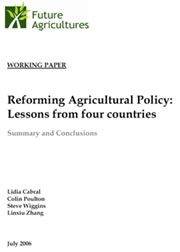{jathumbnail off} Comparing reform of agricultural policy in Bangladesh, Chile, China and New Zealand, this paper derives lessons for countries contemplating reform. In all cases reforms to farm policy wereundertaken as part of overall reforms across the whole economy, started in response to a perceived national crisis and usually implemented by new governments with a mandate to make major changes. Political will is, not surprisingly, a necessary condition.
Comparing reform of agricultural policy in Bangladesh, Chile, China and New Zealand, this paper derives lessons for countries contemplating reform. In all cases reforms to farm policy wereundertaken as part of overall reforms across the whole economy, started in response to a perceived national crisis and usually implemented by new governments with a mandate to make major changes. Political will is, not surprisingly, a necessary condition.
In designing reforms and their implementation, much depends on context, including external conditions such as world market prices. The scope for change, and certainly the sequence and pace of reform, may be as much a matter of administrative feasibility as choice. Where outcomes are uncertain and state capacity limited, gradual approaches to reform that allow for learning may be better than swift and comprehensive ‘big bang’ packages.
This working paper presents the first stage of are view of agricultural reform experiences within African countries, specifically Ethiopia, Kenya and Malawi. It aims to draw out issues for would be reformers by examining the experience of four cases of agricultural reform, purposely selected as often being seen as successful. These are:
• Reform of agricultural input markets in Bangladesh in the early 1980s, followed by liberalisation of grain trading and the cancellation of several longstandingprogrammes of public distribution of grains during the late 1980s and early 1990s;
• The impact of economy-wide reforms andcounter-reform of land on Chilean agriculture from 1973 through to the 1980s;
• Introduction of the ‘household responsibility system’ of production and liberalisation of marketing in China starting around 1978;and,
• Removal of price and other support to New Zealand farming that began in 1984 andcontinued into the 1990s. This review seeks to answer the following questions:
• What were the conditions that created the impetus for agricultural reform?
• What factors determined the actual content of the reform packages?
• What challenges were faced in the implementation of the reform and what lessons, if any, can be learnt from these for future reform programmes?
• What opposition was there to the reforms and how was this overcome?
• What factors exerted the greatest influence on the outcomes of the reform?
The country cases Bangladesh undertook two waves of agriculturalre forms between the late 1970s and early 1990s. In the first, the markets for agricultural inputs. above all fertiliser and irrigation equipment were liberalised. This led to falling prices, greater availability, and increased use of these inputs. Tubewells and pumps, in particular, allowed a major expansion of winter (‘boro’) rice production that saw increases in domestic supply of rice outstrip population growth and thereby drove down the price of rice.
This in turn made it easier to implement the second round of reforms where the markets for food grains were liberalised and some large-scale programmes of food subsidies were ended. Bangladesh benefited from phased implementation of reforms that allowed for learning, monitoring and adjustment to developments in the markets.
